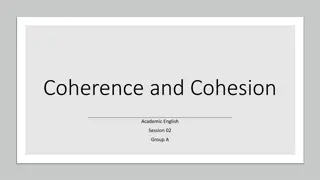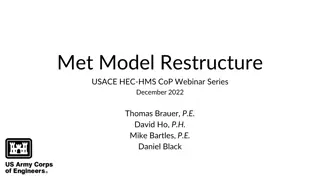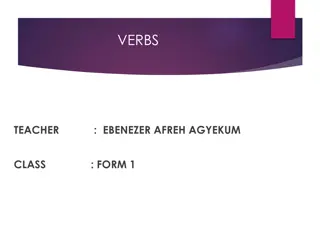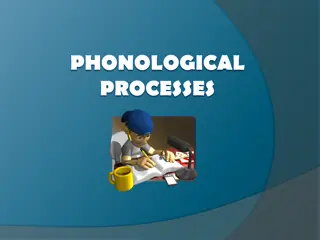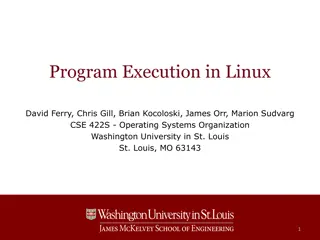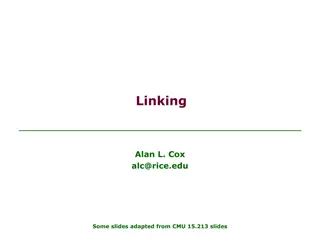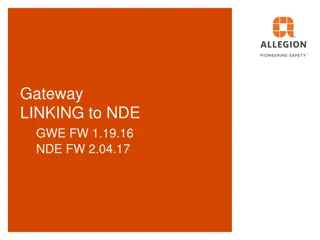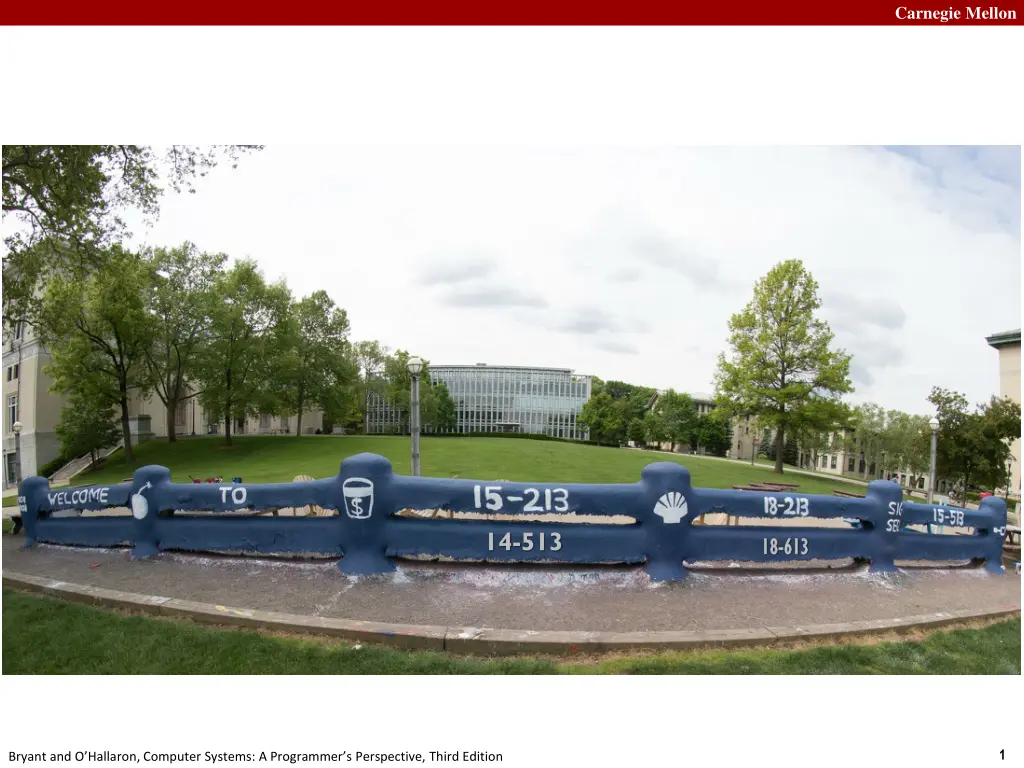
Understanding Carnegie Mellon's Computer Systems Linking Process
Explore the concepts of linking in computer systems at Carnegie Mellon University, focusing on program modularity, efficiency, and the role of linkers. Discover how linking can improve programming skills and prevent errors.
Download Presentation

Please find below an Image/Link to download the presentation.
The content on the website is provided AS IS for your information and personal use only. It may not be sold, licensed, or shared on other websites without obtaining consent from the author. If you encounter any issues during the download, it is possible that the publisher has removed the file from their server.
You are allowed to download the files provided on this website for personal or commercial use, subject to the condition that they are used lawfully. All files are the property of their respective owners.
The content on the website is provided AS IS for your information and personal use only. It may not be sold, licensed, or shared on other websites without obtaining consent from the author.
E N D
Presentation Transcript
Carnegie Mellon 14-513 18 18- -613 613 1 Bryant and O Hallaron, Computer Systems: A Programmer s Perspective, Third Edition
Carnegie Mellon Linking 18-213/18-613: Introduction to Computer Systems 16th Lecture, March 14, 2024 2 Bryant and O Hallaron, Computer Systems: A Programmer s Perspective, Third Edition
Carnegie Mellon Today Linking Motivation What it does How it works Shared libraries and dynamic linking CSAPP 7.1 CSAPP 7.2-7.4 CSAPP 7.5-7.9 CSAPP 7.10-7.12 CSAPP 7.13 Case study: Library interpositioning Understanding linking can help you avoid nasty errors and make you a better programmer. 3 Bryant and O Hallaron, Computer Systems: A Programmer s Perspective, Third Edition
Carnegie Mellon Example C Program int sum(int *a, int n); int sum(int *a, int n) { int i, s = 0; int array[2] = {1, 2}; int main(int argc, char** argv) { int val = sum(array, 2); return val; } for (i = 0; i < n; i++) { s += a[i]; } return s; } sum.c main.c 4 Bryant and O Hallaron, Computer Systems: A Programmer s Perspective, Third Edition
Carnegie Mellon Linking Programs are translated and linked using a compiler driver: linux> gcc -Og -o prog main.c sum.c linux> ./prog main.c sum.c Source files Translators (cpp, cc1, as) Translators (cpp, cc1, as) Separately compiled relocatable object files main.o sum.o Linker (ld) Fully linked executable object file (contains code and data for all functions defined in main.c and sum.c) prog 5 Bryant and O Hallaron, Computer Systems: A Programmer s Perspective, Third Edition
Carnegie Mellon Why Linkers? Reason 1: Modularity Program can be written as a collection of smaller source files, rather than one monolithic mass. Can build libraries of common functions (more on this later) e.g., Math library, standard C library 6 Bryant and O Hallaron, Computer Systems: A Programmer s Perspective, Third Edition
Carnegie Mellon Why Linkers? (cont) Reason 2: Efficiency Time: Separate compilation Change one source file, compile, and then relink. No need to recompile other source files. Can compile multiple files concurrently. Space: Libraries Common functions can be aggregated into a single file... Option 1: Static Linking Executable files and running memory images contain only the library code they actually use Option 2: Dynamic linking Executable files contain no library code During execution, single copy of library code can be shared across all executing processes 7 Bryant and O Hallaron, Computer Systems: A Programmer s Perspective, Third Edition
Carnegie Mellon What Do Linkers Do? Step 1: Symbol resolution Programs define and reference symbols (global variables and functions): void swap() { } /* define symbol swap */ swap(); /* reference symbol swap */ int *xp = &x; /* define symbol xp, reference x */ Symbol definitions are stored in object file (by assembler) in symbol table. Symbol table is an array of entries Each entry includes name, size, and location of symbol. During symbol resolution step, the linker associates each symbol reference with exactly one symbol definition. 8 Bryant and O Hallaron, Computer Systems: A Programmer s Perspective, Third Edition
Carnegie Mellon Symbols in Example C Program Definitions int sum(int *a, int n); int sum(int *a, int n) { int i, s = 0; int array[2] = {1, 2}; int main(int argc, char** argv) { int val = sum(array, 2); return val; } for (i = 0; i < n; i++) { s += a[i]; } return s; } sum.c main.c Reference 9 Bryant and O Hallaron, Computer Systems: A Programmer s Perspective, Third Edition
Carnegie Mellon What Do Linkers Do? (cont d) Step 2: Relocation Merges separate code and data sections into single sections Relocates symbols from their relative locations in the .o files to their final absolute memory locations in the executable. Updates all references to these symbols to reflect their new positions. Let s look at these two steps in more detail . 10 Bryant and O Hallaron, Computer Systems: A Programmer s Perspective, Third Edition
Carnegie Mellon Three Kinds of Object Files (Modules) Relocatable object file (.o file) Contains code and data in a form that can be combined with other relocatable object files to form executable object file. Each .o file is produced from exactly one source (.c) file Executable object file (a.out file) Contains code and data in a form that can be copied directly into memory and then executed. Shared object file (.so file) Special type of relocatable object file that can be loaded into memory and linked dynamically, at either load time or run-time. Called Dynamic Link Libraries (DLLs) by Windows 11 Bryant and O Hallaron, Computer Systems: A Programmer s Perspective, Third Edition
Carnegie Mellon Executable and Linkable Format (ELF) Standard binary format for object files One unified format for Relocatable object files (.o), Executable object files (a.out) Shared object files (.so) Generic name: ELF binaries 12 Bryant and O Hallaron, Computer Systems: A Programmer s Perspective, Third Edition
Carnegie Mellon ELF Object File Format Elf header Word size, byte ordering, file type (.o, exec, .so), machine type, etc. 0 ELF header Segment header table Page size, virtual address memory segments (sections), segment sizes. Segment header table (required for executables) .text section .text section Code .rodata section .data section .rodata section Read only data: jump tables, string constants, ... .bss section .symtab section .data section Initialized global variables .rel.txt section .rel.data section .bss section Uninitialized global variables Block Started by Symbol , Better Save Space Has section header but occupies no space .debug section Section header table 13 Bryant and O Hallaron, Computer Systems: A Programmer s Perspective, Third Edition
Carnegie Mellon ELF Object File Format (cont.) .symtab section Symbol table Procedure and static variable names Section names and locations 0 ELF header Segment header table (required for executables) .rel.text section Relocation info for .textsection Addresses of instructions that will need to be modified in the executable Instructions for modifying .text section .rodata section .data section .bss section .rel.data section Relocation info for .datasection Addresses of pointer data that will need to be modified in the merged executable .symtab section .rel.text section .rel.data section .debug section Info for symbolic debugging (gcc -g) .debug section Section header table Section header table Offsets and sizes of each section 14 Bryant and O Hallaron, Computer Systems: A Programmer s Perspective, Third Edition
Carnegie Mellon Linker Symbols Global symbols Symbols defined by module m that can be referenced by other modules. e.g., non-static C functions and non-static global variables. External symbols Global symbols that are referenced by module m but defined by some other module. Local symbols Symbols that are defined and referenced exclusively by module m. e.g, C functions and global variables defined with the staticattribute. Local linker symbols are not local program variables 15 Bryant and O Hallaron, Computer Systems: A Programmer s Perspective, Third Edition
Carnegie Mellon Step 1: Symbol Resolution Referencing a global that s defined here int sum(int *a, int n); int sum(int *a, int n) { int i, s = 0; int array[2] = {1, 2}; int main(int argc,char **argv) { int val = sum(array, 2); return val; } for (i = 0; i < n; i++) { s += a[i]; } return s; } sum.c main.c Defining a global Linker knows nothing of i or s Referencing a global Linker knows nothing of val that s defined here 16 Bryant and O Hallaron, Computer Systems: A Programmer s Perspective, Third Edition
Carnegie Mellon Symbol Identification Which of the following names will be in the symbol table of symbols.o? Names: incr foo a argc argv b main printf Others? "%d\n" incr foo a argc argv b main printf symbols.c: int incr = 1; static int foo(int a) { int b = a + incr; return b; } int main(int argc, char* argv[]) { printf("%d\n", foo(5)); return 0; } Can find this with readelf: linux> readelf s symbols.o 17 Bryant and O Hallaron, Computer Systems: A Programmer s Perspective, Third Edition
Carnegie Mellon Local Symbols Local non-static C variables vs. local static C variables Local non-static C variables: stored on the stack Local static C variables: stored in either .bss or .data static int x = 15; int f() { static int x = 17; return x++; } Compiler allocates space in .data for each definition of x Creates local symbols in the symbol table with unique names, e.g., x, x.1721 and x.1724. int g() { static int x = 19; return x += 14; } int h() { return x += 27; } Bryant and O Hallaron, Computer Systems: A Programmer s Perspective, Third Edition static-local.c 18
Carnegie Mellon How Linker Resolves Duplicate Symbol Definitions Program symbols are either strong or weak Strong: procedures and initialized globals Weak: uninitialized globals Or ones declared with specifier extern p1.c p2.c int foo=5; int foo; weak strong p1() { } p2() { } strong strong 19 Bryant and O Hallaron, Computer Systems: A Programmer s Perspective, Third Edition
Carnegie Mellon Linker s Symbol Rules Rule 1: Multiple strong symbols are not allowed Each item can be defined only once Otherwise: Linker error Rule 2: Given a strong symbol and multiple weak symbols, choose the strong symbol References to the weak symbol resolve to the strong symbol Rule 3: If there are multiple weak symbols, pick an arbitrary one Can override this with gcc fno-common Puzzles on the next slide 20 Bryant and O Hallaron, Computer Systems: A Programmer s Perspective, Third Edition
Carnegie Mellon Linker Puzzles int x; p1() {} Link time error: two strong symbols (p1) p1() {} int x; p1() {} int x; p2() {} References to x will refer to the same uninitialized int. Is this what you really want? int x; int y; p1() {} double x; p2() {} Writes to x in p2 might overwrite y! Evil! int x=7; int y=5; p1() {} double x; p2() {} Writes to x in p2 might overwrite y! Nasty! References to x will refer to the same initialized variable. int x=7; p1() {} int x; p2() {} Important: Linker does not do type checking. 21 Bryant and O Hallaron, Computer Systems: A Programmer s Perspective, Third Edition
Carnegie Mellon Type Mismatch Example long int x; /* Weak symbol */ /* Global strong symbol */ /* Global strong symbol */ double x = 3.14; double x = 3.14; int main(int argc, char *argv[]) { printf("%ld\n", x); return 0; } mismatch-variable.c mismatch-main.c Compiles without any errors or warnings What gets printed? 22 Bryant and O Hallaron, Computer Systems: A Programmer s Perspective, Third Edition
Carnegie Mellon Global Variables Avoid if you can Otherwise Use static if you can (why?) Initialize if you define a global variable Use extern if you reference an external global variable Treated as weak symbol But also causes linker error if not defined in some file 23 Bryant and O Hallaron, Computer Systems: A Programmer s Perspective, Third Edition
Carnegie Mellon Use of extern in .h Files c1.c global.h extern int g; int f(); #include "global.h" int f() { return g+1; } c2.c #include <stdio.h> #include "global.h int g = 0; int main(int argc, char argv[]) { int t = f(); printf("Calling f yields %d\n", t); return 0; } 24 Bryant and O Hallaron, Computer Systems: A Programmer s Perspective, Third Edition
Carnegie Mellon Step 2: Relocation Relocatable Object Files Executable Object File .text .data 0 System code Headers System data System code main() .text main.o sum() .text main() .data More system code int array[2]={1,2} System data .data sum.o int array[2]={1,2} .text sum() .symtab .debug 26 Bryant and O Hallaron, Computer Systems: A Programmer s Perspective, Third Edition
Carnegie Mellon Relocation Entries int array[2] = {1, 2}; int main(int argc, char** argv) { int val = sum(array, 2); return val; } main.c 0000000000000000 <main>: 0: 48 83 ec 08 sub $0x8,%rsp 4: be 02 00 00 00 mov $0x2,%esi 9: bf 00 00 00 00 mov $0x0,%edi # %edi = &array a: R_X86_64_32 array # Relocation entry e: e8 00 00 00 00 callq 13 <main+0x13> # sum() f: R_X86_64_PC32 sum-0x4 # Relocation entry 13: 48 83 c4 08 add $0x8,%rsp 17: c3 retq main.o Source: objdump r d main.o 27 Bryant and O Hallaron, Computer Systems: A Programmer s Perspective, Third Edition
Carnegie Mellon Relocated .text section 00000000004004d0 <main>: 4004d0: 48 83 ec 08 sub $0x8,%rsp 4004d4: be 02 00 00 00 mov $0x2,%esi 4004d9: bf 18 10 60 00 mov 4004de: e8 05 00 00 00 callq 4004e8 <sum> # sum() 4004e3: 48 83 c4 08 add $0x8,%rsp 4004e7: c3 retq $0x601018,%edi # %edi = &array 00000000004004e8 <sum>: 4004e8: b8 00 00 00 00 mov 4004ed: ba 00 00 00 00 mov 4004f2: eb 09 jmp 4004f4: 48 63 ca movslq %edx,%rcx 4004f7: 03 04 8f add (%rdi,%rcx,4),%eax 4004fa: 83 c2 01 add $0x1,%edx 4004fd: 39 f2 cmp 4004ff: 7c f3 jl 400501: f3 c3 repz retq $0x0,%eax $0x0,%edx 4004fd <sum+0x15> %esi,%edx 4004f4 <sum+0xc> callq instruction uses PC-relative addressing for sum(): 0x4004e8 = 0x4004e3 + 0x5 Source: objdump -d prog 28 Bryant and O Hallaron, Computer Systems: A Programmer s Perspective, Third Edition
Carnegie Mellon Loading Executable Object Files Memory invisible to user code Executable Object File Kernel virtual memory 0 ELF header User stack (created at runtime) Program header table (required for executables) %rsp (stack pointer) .init section .text section Memory-mapped region for shared libraries .rodata section .data section .bss section brk Run-time heap (created by malloc) .symtab .debug Loaded from the executable file Read/write data segment (.data, .bss) .line .strtab Read-only code segment (.init, .text, .rodata) Section header table (required for relocatables) 0x400000 Unused 0 29 Bryant and O Hallaron, Computer Systems: A Programmer s Perspective, Third Edition
Carnegie Mellon Quiz Time! Canvas Quiz: Day 16 Linking 30 Bryant and O Hallaron, Computer Systems: A Programmer s Perspective, Third Edition
Carnegie Mellon Today Linking Motivation What it does How it works Shared libraries and dynamic linking Case study: Library interpositioning 31 Bryant and O Hallaron, Computer Systems: A Programmer s Perspective, Third Edition
Carnegie Mellon Commonly Used Libraries libc.a (the C standard library) 4.6 MB archive of 1496 object files. I/O, memory allocation, signal handling, string handling, data and time, random numbers, integer math libm.a (the C math library) 2 MB archive of 444 object files. floating point math (sin, cos, tan, log, exp, sqrt, ) % ar t /usr/lib/libc.a | sort fork.o fprintf.o fpu_control.o fputc.o freopen.o fscanf.o fseek.o fstab.o % ar t /usr/lib/libm.a | sort e_acos.o e_acosf.o e_acosh.o e_acoshf.o e_acoshl.o e_acosl.o e_asin.o e_asinf.o e_asinl.o 32 Bryant and O Hallaron, Computer Systems: A Programmer s Perspective, Third Edition
Carnegie Mellon Libraries: Packaging a Set of Functions How to package functions commonly used by programmers? Math, I/O, memory management, string manipulation, etc. Awkward, given the linker framework so far: Option 1: Put all functions into a single source file Programmers link big object file into their programs Space and time inefficient Option 2: Put each function in a separate source file Programmers explicitly link appropriate binaries into their programs More efficient, but burdensome on the programmer 33 Bryant and O Hallaron, Computer Systems: A Programmer s Perspective, Third Edition
Carnegie Mellon Old-Fashioned Solution: Static Libraries Static libraries (.a archive files) Concatenate related relocatable object files into a single file with an index (called an archive). Enhance linker so that it tries to resolve unresolved external references by looking for the symbols in one or more archives. If an archive member file resolves reference, link it into the executable. 34 Bryant and O Hallaron, Computer Systems: A Programmer s Perspective, Third Edition
Carnegie Mellon Creating Static Libraries atoi.c printf.c random.c ... Translator Translator Translator atoi.o printf.o random.o unix> ar rs libc.a \ atoi.o printf.o random.o Archiver (ar) libc.a C standard library Archiver allows incremental updates Recompile function that changes and replace .o file in archive. 35 Bryant and O Hallaron, Computer Systems: A Programmer s Perspective, Third Edition
Carnegie Mellon Linking with Static Libraries libvector.a void addvec(int *x, int *y, int *z, int n) { int i; #include <stdio.h> #include "vector.h" int x[2] = {1, 2}; int y[2] = {3, 4}; int z[2]; for (i = 0; i < n; i++) z[i] = x[i] + y[i]; } addvec.c int main(int argc, char** argv) { addvec(x, y, z, 2); printf("z = [%d %d]\n , z[0], z[1]); return 0; } void multvec(int *x, int *y, int *z, int n) { int i; for (i = 0; i < n; i++) z[i] = x[i] * y[i]; main2.c } multvec.c 36 Bryant and O Hallaron, Computer Systems: A Programmer s Perspective, Third Edition
Carnegie Mellon Linking with Static Libraries multvec.o addvec.o main2.c vector.h Archiver (ar) Translators (cpp, cc1, as) Static libraries libvector.a libc.a printf.o and any other modules called by printf.o Relocatable object files main2.o addvec.o Linker (ld) unix> gcc static o prog2c \ main2.o -L. -lvector Fully linked executable object file (861,232 bytes) prog2c c for compile-time 37 Bryant and O Hallaron, Computer Systems: A Programmer s Perspective, Third Edition
Carnegie Mellon Using Static Libraries Linker s algorithm for resolving external references: Scan .o files and .a files in the command line order. During the scan, keep a list of the current unresolved references. As each new .o or .a file, obj, is encountered, try to resolve each unresolved reference in the list against the symbols defined in obj. If any entries in the unresolved list at end of scan, then error. Problem: Command line order matters! Moral: put libraries at the end of the command line. unix> gcc -static -o prog2c -L. -lvector main2.o main2.o: In function `main': main2.c:(.text+0x19): undefined reference to `addvec' collect2: error: ld returned 1 exit status 38 Bryant and O Hallaron, Computer Systems: A Programmer s Perspective, Third Edition
Carnegie Mellon Modern Solution: Shared Libraries Static libraries have the following disadvantages: Duplication in the stored executables (every function needs libc) Duplication in the running executables Minor bug fixes of system libraries require each application to explicitly relink Rebuild everything with glibc? https://security.googleblog.com/2016/02/cve-2015-7547-glibc- getaddrinfo-stack.html Modern solution: shared libraries Object files that contain code and data that are loaded and linked into an application dynamically, at either load-time or run-time Also called: dynamic link libraries, DLLs, .so files 39 Bryant and O Hallaron, Computer Systems: A Programmer s Perspective, Third Edition
Carnegie Mellon Shared Libraries (cont.) Dynamic linking can occur when executable is first loaded and run (load-time linking) Common case for Linux, handled automatically by the dynamic linker (ld-linux.so) Standard C library (libc.so) usually dynamically linked Dynamic linking can also occur after program has begun (run-time linking) In Linux, this is done by calls to the dlopen() interface Distributing software High-performance web servers Runtime library interpositioning Shared library routines can be shared by multiple processes Using the virtual-to-physical memory mapping 40 Bryant and O Hallaron, Computer Systems: A Programmer s Perspective, Third Edition
Carnegie Mellon What dynamic libraries are required? .interp section Specifies the dynamic linker to use (i.e., ld-linux.so) .dynamic section Specifies the names, etc of the dynamic libraries to use Follow an example of prog (NEEDED) Shared library: [libm.so.6] Where are the libraries found? Use ldd to find out: unix> ldd prog linux-vdso.so.1 => (0x00007ffcf2998000) libc.so.6 => /lib/x86_64-linux-gnu/libc.so.6 (0x00007f99ad927000) /lib64/ld-linux-x86-64.so.2 (0x00007f99adcef000) 41 Bryant and O Hallaron, Computer Systems: A Programmer s Perspective, Third Edition
Carnegie Mellon Dynamic Library Example addvec.c multvec.c unix> gcc Og c addvec.c multvec.c -fpic Translator Translator addvec.o multvec.o unix> gcc -shared -o libvector.so \ addvec.o multvec.o Loader (ld) Dynamic vector library libvector.so 42 Bryant and O Hallaron, Computer Systems: A Programmer s Perspective, Third Edition
Carnegie Mellon Dynamic Linking at Load-time main2.c vector.h unix> gcc -shared -o libvector.so \ addvec.c multvec.c -fpic Translators (cpp, cc1, as) libc.so libvector.so Relocatable object file main2.o Relocation and symbol table info Linker (ld) unix> gcc o prog2l \ main2.o ./libvector.so Partially linked executable object file (8488 bytes) prog2l Loader (execve) libc.so libvector.so Code and data Fully linked executable in memory Dynamic linker (ld-linux.so) 43 Bryant and O Hallaron, Computer Systems: A Programmer s Perspective, Third Edition
Carnegie Mellon Dynamic Linking: Global Offset Table(GOT) Data segment Global offset table (GOT) GOT[0]: GOT[1]: GOT[2]: GOT[3]: &addcnt Fixed distance of 0x2008b9 bytes at run time between GOT[3] and addl instruction. Code segment addvec: mov 0x2008b9(%rip),%rax # %rax=*GOT[3]=&addcnt addl $0x1,(%rax) # addcnt++ The GOT is an array of pointers, with one entry per dynamically linked function (and then a few) The dynamic linker populates this table as it links each such function at runtime Calls to dynamically linked functions are made using indirection via the corresponding entry in the GOT 44 Bryant and O Hallaron, Computer Systems: A Programmer s Perspective, Third Edition
Carnegie Mellon Dynamic Linking: Procedure Linkage Table (PLT): Initial Initially, all entries in the GOT point right back to the next instruction in the PLT This instruction, and the one that follows it, call the dynamic linker, which in turn maps in the function and adjusts the GOT to point to it 45 Bryant and O Hallaron, Computer Systems: A Programmer s Perspective, Third Edition
Carnegie Mellon Dynamic Linking: Procedure Linkage Table (PLT): Steady State Once the dynamic linker is done, the GOT contains the address of the function The dynamic linker calls the newly linked function Subsequent calls will succeed without the intervention of the dynamic linker. 46 Bryant and O Hallaron, Computer Systems: A Programmer s Perspective, Third Edition
Carnegie Mellon Dynamic Linking API for Run-time Linking #include <stdio.h> #include <stdlib.h> #include <dlfcn.h> int x[2] = {1, 2}; int y[2] = {3, 4}; int z[2]; int main(int argc, char** argv) { void *handle; void (*addvec)(int *, int *, int *, int); char *error; /* Dynamically load the shared library that contains addvec() */ handle = dlopen("./libvector.so", RTLD_LAZY); if (!handle) { fprintf(stderr, "%s\n", dlerror()); exit(1); } . . . dll.c 47 Bryant and O Hallaron, Computer Systems: A Programmer s Perspective, Third Edition
Carnegie Mellon Dynamic Linking API (cont d) ... /* Get a pointer to the addvec() function we just loaded */ addvec = dlsym(handle, "addvec"); if ((error = dlerror()) != NULL) { fprintf(stderr, "%s\n", error); exit(1); } /* Now we can call addvec() just like any other function */ addvec(x, y, z, 2); printf("z = [%d %d]\n", z[0], z[1]); /* Unload the shared library */ if (dlclose(handle) < 0) { fprintf(stderr, "%s\n", dlerror()); exit(1); } return 0; } dll.c 48 Bryant and O Hallaron, Computer Systems: A Programmer s Perspective, Third Edition
Carnegie Mellon Dynamic Linking API dll.c vector.h unix> gcc -shared -o libvector.so \ addvec.c multvec.c -fpic Translators (cpp, cc1, as) libvector.so libc.so Relocatable object file dll.o Relocation and symbol table info Linker (ld) unix> gcc -rdynamic o prog2r \ dll.o -ldl prog2r libc.so Partially linked executable object file (8784 bytes) Loader (execve) Code and data Dynamic linker (ld-linux.so) Fully linked executable in memory Call to dynamic linker via dlopen 49 Bryant and O Hallaron, Computer Systems: A Programmer s Perspective, Third Edition
Carnegie Mellon Linking Summary Linking is a technique that allows programs to be constructed from multiple object files Linking can happen at different times in a program s lifetime: Compile time (when a program is compiled) Load time (when a program is loaded into memory) Run time (while a program is executing) Understanding linking can help you avoid nasty errors and make you a better programmer 50 Bryant and O Hallaron, Computer Systems: A Programmer s Perspective, Third Edition
Carnegie Mellon Today Linking Motivation What it does How it works Shared libraries and dynamic linking Case study: Library interpositioning 51 Bryant and O Hallaron, Computer Systems: A Programmer s Perspective, Third Edition

![Read⚡ebook✔[PDF] Linking the Space Shuttle and Space Stations: Early Docking Te](/thumb/21519/read-ebook-pdf-linking-the-space-shuttle-and-space-stations-early-docking-te.jpg)

